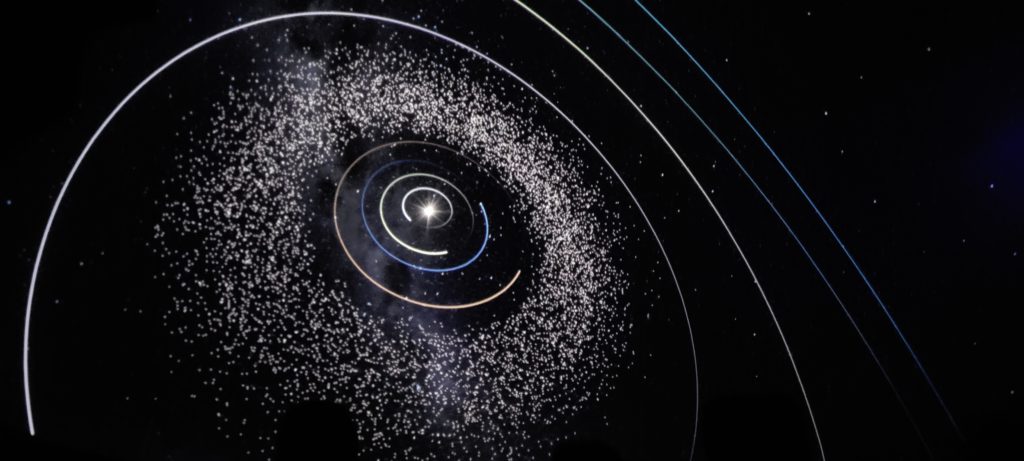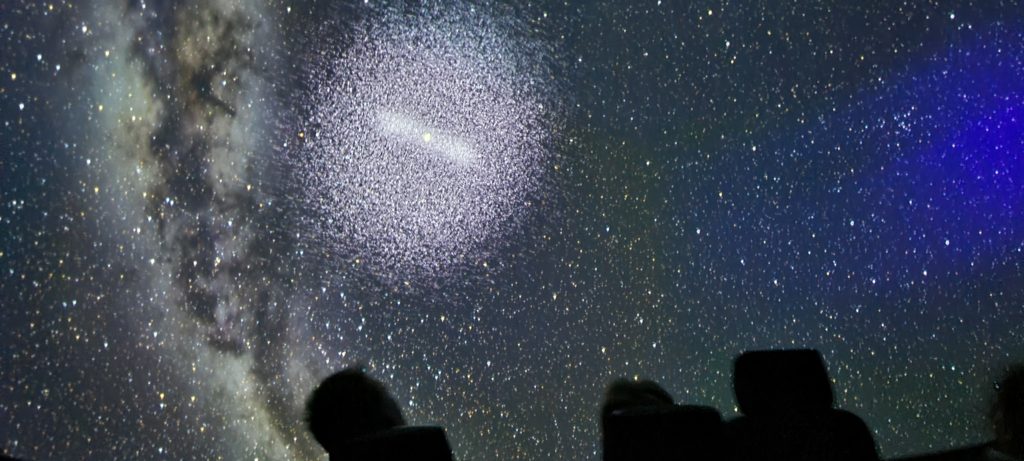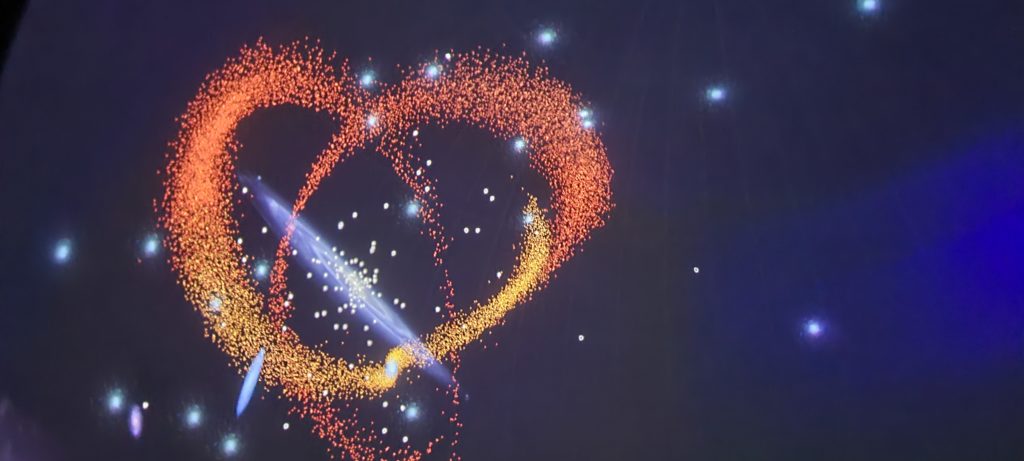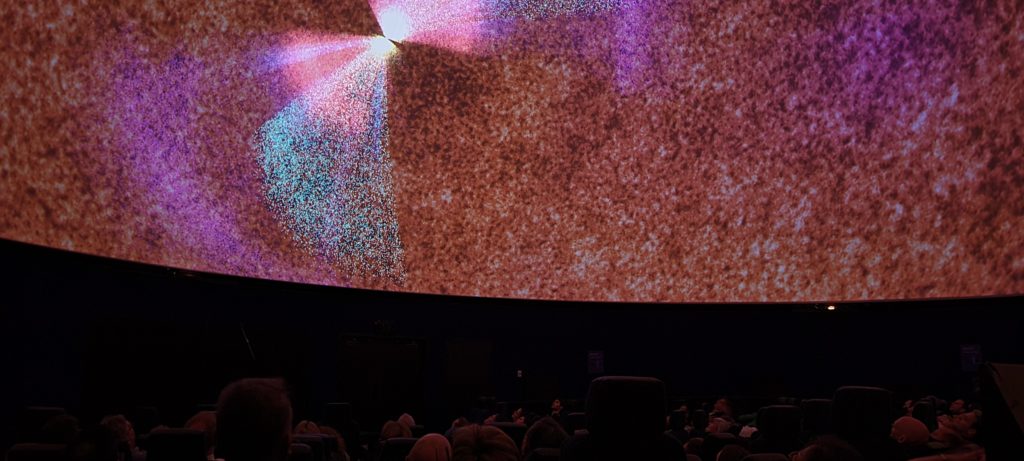A RARE Ticket to the Universe
by Dr Catriona Nguyen-Robertson MRSV

The following article follows a presentation of Ticket to the Universe by Museum Victoria’s Senior Curator of Astronomy, Dr Tanya Hill, in Melbourne Planetarium. This event was part of Inspiring Victoria’s RARE program for National Science Week.
After two years of celebrating virtually, the Victorian science engagement community was delighted to meet in-person again to mark the 25th birthday of National Science Week. Surrounded by mysterious, enthralling space in the comfort of Melbourne Planetarium, Rob Gell AM officially declared the beginning of Science Week in Victoria for 2022.
Rob noted that we have entered an era of great global and regional disruption, during which scientific literacy and skills have become more important than ever. It is therefore encouraging to see many people sharing the excitement, challenge, and utility of scientific work with Victorians across the state.
Those who attended the Science Week Launch were treated to a “quick trip” through the Universe guided by astronomer, Dr Tanya Hill. While it is a little tricky to take a brief tour of the observable Universe, given that its diameter is 93 billion light-years (8.8 x 1023 km) – and still expanding – Tanya managed to zip through faster than the speed of light, pointing out highlights of ‘rare’ phenomena along the way.
Astronomers have an interesting relationship with the idea of ‘rare’. Things we seldom see on Earth may be commonplace at a universal scale. Conversely, things all around us that we take for granted may actually be quite rare phenomena. Heavy metals like iridium are more common in asteroids than on Earth’s surface, whereas wood, oil and coal are scarcer in the whole Universe than diamonds.
As astronomer Carl Sagan wrote in his 1994 book, Pale Blue Dot, ‘the Earth is a very small stage in a vast cosmic arena’.
While we are so familiar with our home planet, it may in fact be an example of something quite rare. Our exploration of space has been nothing short of astonishing in terms of the images and scientific data attained, and yet all the worlds we have seen beyond Earth appear to be completely void of any evidence of life.
We simply do not know how abundant life is in the Universe. Mathematically speaking, the chances that we are alone are low. But even if extra-terrestrial life exists, is it as simple (relatively speaking) as a bacterium, or is it complex like a multi-cellular organism? If there is intelligent life, how intelligent is it? The unique conditions on Earth that allowed complex life to flourish may be unlikely to occur throughout the Universe. To learn more, we need data we do not have…yet.
But if there is intelligent life out there, they could be collecting data on us. In this expansive Universe, are we the only planet broadcasting our activities into space? Launched in 1977, Voyager 1 is now 23.6 billion kilometres away with Voyager 2 around 3 billion km behind. Both carry metal plaques identifying the time and place of their origin as well as a golden record to communicate the sounds and story of Earth to extra-terrestrials. We also broadcast radio waves into deep space, with an ever-expanding bubble announcing the presence of humanity to anyone listening. For anyone listening, they could tune into the first Big Brother Australia series (2001) at 21 light years away, the beginning of Neighbours (1985) at 36 light years, or the first television broadcast (1927) at 95 light years. We are alive, and we are noisy.

It may be the case that we owe our existence to the Moon: life only appeared on Earth some 700 million years after the Moon formed, and life as we know it would not exist without it. We may take our Moon for granted, but Earth is the only rocky planet in the Solar System that has a substantial Moon. Neither Mercury nor Venus has a moon, and while Mars has two moons – Phobos and Deimos – they are quite small. If Deimos hovered above Melbourne with one end at Scienceworks, the other end would only reach the CBD (13 km). Doing the same with Phobos, it would reach out to around Heidelberg (22 km). The size of our Moon means that it makes our planet more liveable by stabilising Earth’s axial wobble to allow for a relatively stable climate. The Moon’s pull also creates the oscillating ocean tides that allowed ancient marine microbes to thrive and eventually evolve.
Moving further away from Earth, we pass by different planets. Each a unique world. But we cannot discuss rarity in our solar system without mentioning poor Pluto. Since its discovery in 1930, it did not quite fit in. Literally – its erratic orbit does not align with the flat plane of other planetary orbits. Smaller than any other planet – even smaller than our Moon – and so far away, it has not completed a full orbit around the Sun since its discovery. Although, now it has found its place, or rather, we have found a place for it as a “dwarf planet”. There are currently five official dwarf planets with up to a thousand other candidates. Perhaps Pluto is not so alone after all!
The Solar System extends far beyond Pluto and the Kuiper Belt, to the Oort Cloud, for possibly a full light year. When light leaves the Sun, it takes a little over eight minutes to reach us on Earth, and about 4.5 hours to reach Neptune. Add another three hours and the Sun’s light passes beyond the edge of the Kuiper Belt, yet it does not reach the inner edge of the Oort Cloud for another 10 to 28 days. The Oort Cloud is thought to be a giant bubble around our solar system, comprised of icy, comet-like objects – and it really is giant. In fact, it may be perhaps as much as a year and a half before sunlight reaches the edge of it and the Solar System.

As you fly further away from home, you realise that the Sun is simply one of the billions of stars that form the Milky Way Galaxy. Beyond the Solar System are worlds that orbit other stars (with rogue planets that answer to no star, scattered in between). The Kepler Mission estimates that 40 billion rocky, Earth-like exoplanets orbit stars like our Sun or red dwarf stars in our region of the Milky Way Galaxy. Is Earth perhaps not so special?
You also realise that the stellar constellations we see in the night sky are rare: they can only be seen from Earth (or more accurately, from our solar system). We draw 2D pictures in the night sky by connecting stars together when each star is in fact quite far apart in space. The only thing that links stars in a constellation is our perception. The individual stars we see only comprise a small portion of the galaxy, and because are stuck inside the plane of the Milky Way Galaxy, we will never see a face-on view of its beautiful spiral. (Although, we do bob up and down in its plane, causing the Milky Way band across the sky to become thicker or thinner).
Stars located within the stellar halo would see something entirely different. A stellar halo is a spherical group of stars that surround most disk galaxies, and those stars in the Milky Way Galaxy halo are the galaxy’s oldest stars. They orbit in the outskirts of the galaxy and are not bound inside the plane. If anyone lived on a planet orbiting a halo star, they would see the full face of the Milky Way Galaxy at some parts of the year…and at other times, they would see absolutely nothing in their night sky.

Part of the reason there are so many stars in the Milky Way Galaxy may be because of our little neighbour, the Sagittarius Dwarf Galaxy. On its looping, spiraling orbit, it has passed through our galaxy at least three times. Each time it has passed through it has left a trail of stars that were pulled out of it by our galaxy. As Dr Hill says, ‘These stars are like breadcrumbs that litter the sky’. Not only were stars left behind each time the Sagittarius Dwarf Galaxy barged through the plane of the Milky Way Galaxy, but the events also sparked the formation of new stars. Its first passage five billion years ago coincides with the formation of the Sun and our solar system – perhaps we are only here because of this small galaxy.
For much of human history, it was thought that the Milky Way Galaxy was all that existed: it was the whole Universe. Yet even though nearly all of them are invisible to our eyes, the observable Universe, extending tens of billions of light years in all directions, contains a fantastically large number of galaxies within it. And no one knows just how big the Universe really is.
The furthest thing we can see is the cosmic microwave background, a glow that fills the entire Universe. This light is nearly 14 billion years old, leftover from the Big Bang. If you remember the days of the static between channels on an old analogue television, some of that static could be attributed to this ancient afterglow.

Within our mind-bogglingly large Universe, with all the stars in all the galaxies, there are more stars than there are grains of sand on our entire planet. Although there is nothing particularly remarkable about our star, the Sun, our “pale blue dot” might be another story.
For now, there is nowhere else that we could live – at least in not our immediate surroundings. Nor have we found signs of other life in the Universe. There is a chance that we could be the rarest things of all.






